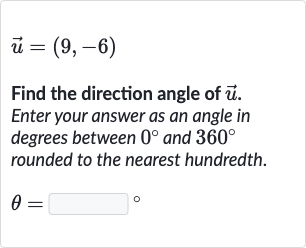Full solution
Q. Find the direction angle of . Enter your answer as an angle in degrees between and rounded to the nearest hundredth.
- Calculate Ratio: To find the direction angle of the vector , we need to calculate the angle that the vector makes with the positive x-axis. The direction angle can be found using the arctangent function, which is the inverse of the tangent function. The tangent of the angle is the ratio of the y-coordinate to the x-coordinate of the vector. However, since the y-coordinate is negative and the x-coordinate is positive, the vector lies in the fourth quadrant, and we must add degrees to the arctangent of the ratio to get the angle in the range [, ) degrees.
- Find Arctangent: First, calculate the ratio of the y-coordinate to the x-coordinate of the vector :.
- Calculate Angle: Next, use the arctangent function to find the angle that corresponds to this ratio. Remember that the arctangent function will give us an angle in the range , so we need to adjust it for the fourth quadrant..
- Adjust for Quadrant: Using a calculator, we find that:.Since this angle is in the fourth quadrant, we add degrees to get the direction angle in the range [, ) degrees..
- Find Final Angle: Perform the addition to find the final direction angle:.
More problems from Inverses of sin, cos, and tan: degrees
QuestionGet tutor help
QuestionGet tutor help
QuestionGet tutor help
QuestionGet tutor help
QuestionGet tutor help
QuestionGet tutor help
Question
. Find the value of in degrees.Write your answer in simplified, rationalized form. Do not round.____
Get tutor helpQuestionGet tutor help

